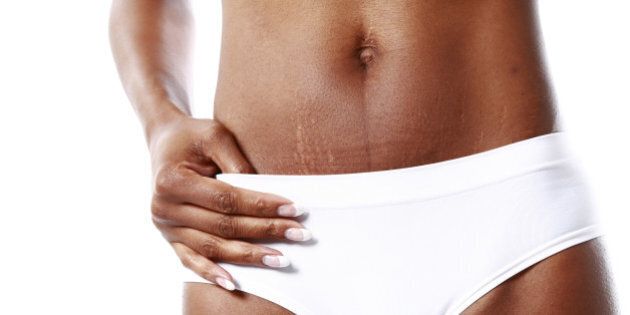

Google 'stretch marks' and prepare to be inundated with companies boasting of an array of balms and treatments "guaranteed" to make them magically vanish from your skin in no time at all.
You know the kind. 'Had a baby? No worries! Just rub this essence of coconut/coffee scrub/almond butter balm into your belly three times a day and prepare for your skin to glow like an 18 year-old nymph's.' And so on.
Of course, the problem with these kinds of promises is, if it sounds too good to be true, it probably is.
So what is the go with the prevention and/or treatment of stretch marks? The Huffington Post Australia spoke to spokesperson for the Australasian College of Dermatologists Dr Michael Freeman to find out.
What causes stretch marks in the first place?
Basically, stretch marks are caused due to a break in elastin in the skin.
"Our skin is made up of a number of different structure components, including collagen and elastin," Freeman told The Huffington Post Australia.
"Elastin is which gives it resilience and that 'spring back'. When it comes to stretch marks, that physically breaks. The reason behind that breaking is that the skin can't physically stretch as far [as the body is requiring it to], so it's actually breaking in a controlled way.
"That's why you don't see stretch marks exactly together. They're actually a little bit separated. What that does, is it's allowing the skin to concertina out and grow larger.
"This happens when there is too much pressure on that skin, the classic example being pregnancy,
"You will also see it in pubescent girls, especially, if their breasts are enlarging rapidly, that area of skin might stretch. Or their hips or bottom. It can also happen in men, particularly teenagers who go through a rapid growth spurt. You will see horizontal stretch marks on a man's back if that happens.
"Stretch marks can also occur if you put on a lot of fat quickly. We see this happen sometimes if someone is taking cortisone, as it can also weaken the structural elements in the skin."

Is it possible to reduce the appearance of stretch marks?
According to Freeman, the answer is a loose 'yes', BUT... well, there are plenty of 'buts'.
"When stretch marks first occur, there's a lot of redness in the scar or mark. That red is really well treated by a pulsed dye laser, which dramatically drops the redness back. It also improves the collagen and elastin to a degree, meaning the end result is a stretch mark that looks a lot better.
"If you were to wait 18 months or so for the redness to go down, it would look fairly similar, but you would be fractionally better off having had the laser."
In terms of stretch marks that are already 'mature', Freeman says a fractional CO2 laser is one of the best available.
"There is evidence that some of the new fractioned lasers have made a slight improvement to stretch marks," he told HuffPost Australia.
"But you can't do this while your skin is still stretching. Only when the stretch marks are mature."
What about prevention?
"One thing you could do is try to stretch the skin out slower," Freeman said. "So, if one could stack on some weight before they got pregnant, and then try to slim out while the baby grows into that weight. That could potentially reduce the appearance of stretch marks.
"Massaging can also help, but I would say controlling your weight is the biggest one."
Wait. What about all these potions and lotions on the market?
"It’s quite tragic that all of us want us to have a magic cure," Freeman said.
"It means we are prepared to, if something works somewhere else, to assume it will work in all circumstances, while that isn't the case.
"For example, if you have a cut and you scar yourself, any oil at all -- whether it's Bio-Oil or Vaseline or heavy moisturiser -- will improve the scar so it’s not hypertrophic (when the scar mounds up into a mound) and not keloid (where it mounds way beyond the scar.)
"Because it works there, people assume it also works on stretch marks, but there is actually no proof it makes any difference whatsoever.
"There are also no drugs I am aware of that will make any difference, and no internal supplements. I think that's important to include because at the drop of a hat, people will rush out and take all sorts of multi vitamins. In reality, if your diet is reasonably balanced, these types of vitamins could actually be harmful."